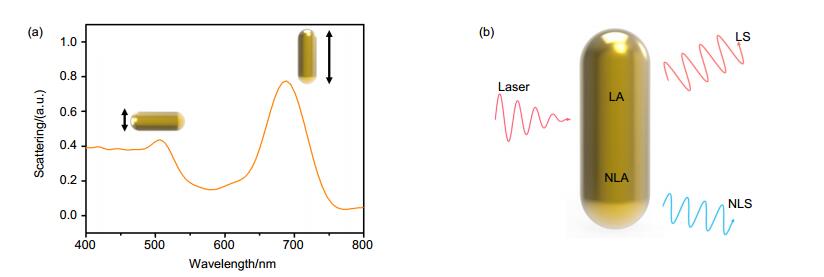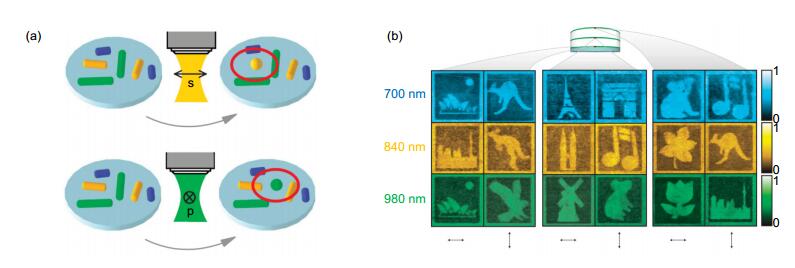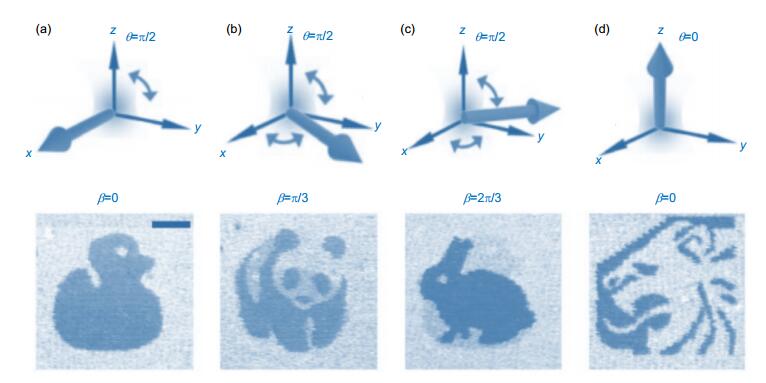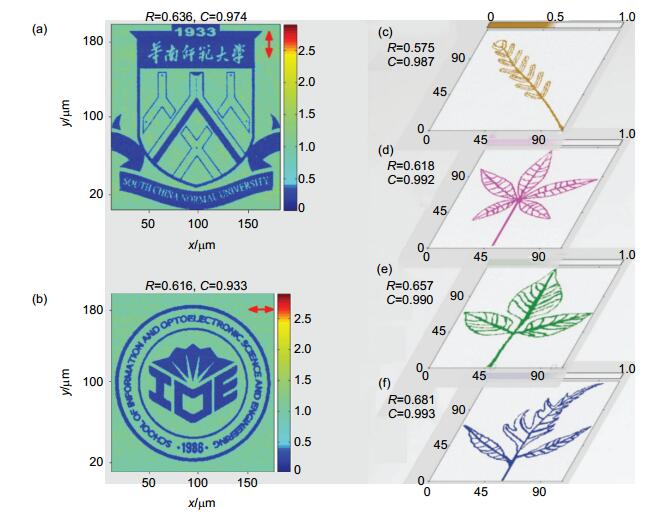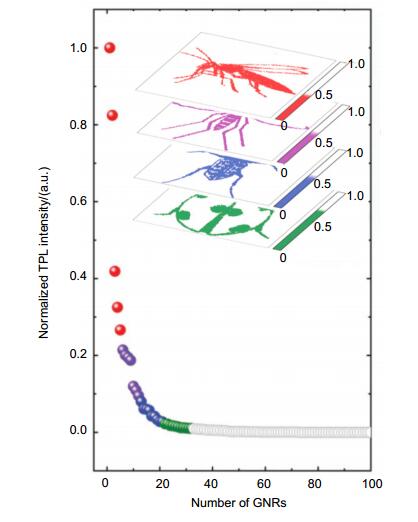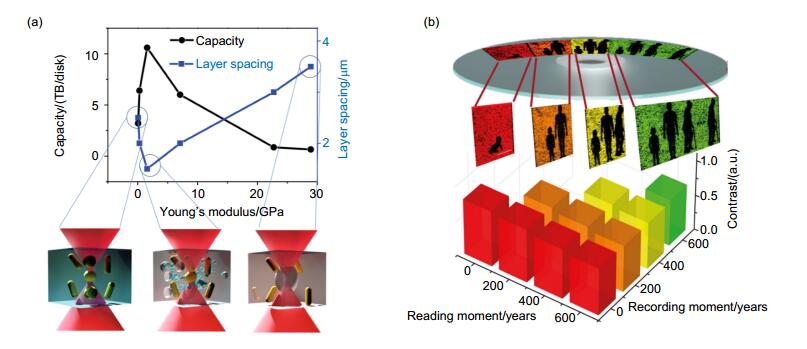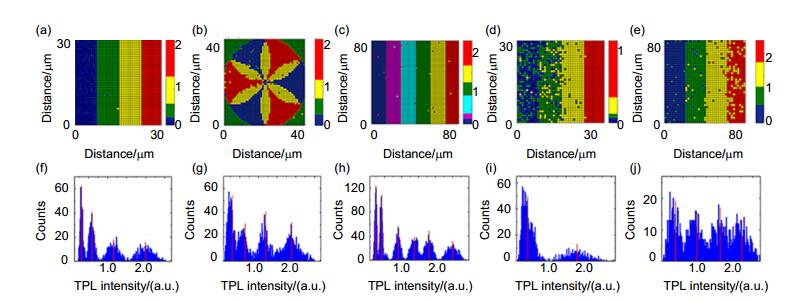-
摘要
随着信息时代的到来,日益增长的海量数据对数据存储技术提出了高容量、高安全性和高存储时长等要求。常规的磁存储技术难以满足这些要求,面临着前所未有的挑战。随着激光器的发明和纳米技术的快速发展,基于金纳米棒与读写激光相互作用的五维光存储技术应运而生,其存储密度高和寿命长的特点能够满足上述要求。本文将总结如何从结构物质的角度来实现读写激光物理维度的复用和多进制存储以及如何从结构光的角度来实现超分辨存储。本文还将讨论进一步提升五维光存储容量的方法,并对这种技术的未来发展方向进行展望。
Abstract
The digital data created by human being grows exponentially in time. Conventional magnetic storage technologies are difficult to meet this challenge. It means that new storage technologies with higher capacity, higher security and longer storage time should be developed to meet the challenge in information age. With the invention of lasers and the rapid development of nanotechnology, multidimensional optical data storage based on the polarization and wavelength dependent responses of gold nanorods was demonstrated to be capable of meeting these requirements. We will review the recent progresses about five-dimensional optical data storage and multilevel storage utilizing disorder gold nanorod from the structured matter point of view and super resolution storage from the structured light point of view, respectively. We also provide outlooks for how to further increase the capacity of the five dimensional optical data storage and our future prospective of this technology.
-
Key words:
- optical data storage /
- super resolution storage /
- multilevel storage /
-
Overview

Overview: The digital data created by human being grows exponentially in time. Conventional magnetic storage technologies are difficult to meet this challenge. It means that new storage technologies with higher capacity, higher security and longer storage time should be developed to meet such challenge in information era. With the invention of lasers and the rapid development of nanotechnology, optical data storage technology based on light-matter interaction was shown to be a potential solution to this end. However, commercial optical data storage technologies are currently difficult to meet the increasing requirement for big data storage. Researchers are going to explore new means to further increase storage capacity to meet the growing requirements for massive data storage. For example, the capacities of multi-dimensional optical data storage, super-resolution optical data storage and multi-level optical data storage technologies were demonstrated to be much larger than traditional optical storage technologies. Herein, we review the recent progresses of multi-dimensional optical data storage, super-resolution optical data storage and multi-level optical data storage technology, with the focus on multi-dimensional optical storage technology. The gold nanorod (GNR) shows unique properties of a longitudinal surface plasmon resonance. By using the wavelength and polarization dependent responses of GNRs, five-dimensional (the wavelength and polarization of light and the three spatial dimensions) optical data storage has been demonstrated with TB scale storage capacity for the same volume of a DVD disc. In order to increase the number of information channels in the focused spot volume for this kind of optical storage technology, the intuitive approach is to increase the number of GNRs per unit volume, which inevitably increase the coupling strength among GNRs. Therefore, hot spots will be formed in the small gaps among GNRs. As a result, rather than using the response of a single GNR, the polarization and wavelength sensitivity of random hot spots in a volume GNR assembly can be used to encoded information and realize multi-dimensional data storage. At the same time, the plasmonic coupling among GNRs can also significantly enhance linear absorption and two-photon induced luminescence of the GNRs. As a result, five-dimensional optical data storage by encoding random hot spots of a volume GNR can be realized by using an ultralow energy. This technology improves significantly both the quality and capacity of optical data storage. We also provide outlooks for how to further increase the capacity of the five dimensional optical data storage and our future prospective of this technology.
-

-
-
参考文献
[1] Seagete Technology LLC. Data age 2025 - the digitization of the world[EB/OL]. 2018. https://www.seagate.com/our-story/data-age-2025/
[2] Horimai H, Tan X D. Collinear technology for a holographic versatile disk[J]. Applied Optics, 2006, 45(5): 910-914. doi: 10.1364/AO.45.000910
[3] Tan X D, Lin X, Wu A A, et al. High density collinear holographic data storage system[J]. Frontiers of Optoelectronics, 2014, 7(4): 443-449. doi: 10.1007/s12200-014-0399-1
[4] Lin X, Huang Y, Shimura T, et al. Fast non-interferometric iterative phase retrieval for holographic data storage[J]. Optics Express, 2017, 25(25): 30905-30915. doi: 10.1364/OE.25.030905
[5] Mansuripur M. Effects of high-numerical-aperture focusing on the state of polarization in optical and magneto-optic data storage systems[J]. Applied Optics, 1991, 30(22): 3154-3162. doi: 10.1364/AO.30.003154
[6] Mansuripur M, Zakharian A R, Lesuffleur A, et al. Plasmonic nano-structures for optical data storage[J]. Optics Express, 2009, 17(16): 14001-14014. doi: 10.1364/OE.17.014001
[7] Mansuripur M, Sincerbox G. Principles and techniques of optical data storage[J]. Proceedings of the IEEE, 1997, 85(11): 1780-1796. doi: 10.1109/5.649657
[8] Airy G B. On the diffraction of an object-glass with circular aperture[J]. Transactions of the Cambridge Philosophical Society, 1835, 5: 283-291.
[9] Gu M, Li X P, Cao Y Y. Optical storage arrays: a perspective for future big data storage[J]. Light: Science & Applications, 2014, 3(5): e177.
[10] Gu M, Zhang Q M, Lamon S. Nanomaterials for optical data storage[J]. Nature Reviews Materials, 2016, 1(12): 16070. doi: 10.1038/natrevmats.2016.70
[11] Oh W Y, Yun S H, Vakoc B J, et al. High-speed polarization sensitive optical frequency domain imaging with frequency multiplexing[J]. Optics Express, 2008, 16(2): 1096-1103. doi: 10.1364/OE.16.001096
[12] Aiki K, Nakamura M, Umeda J. Frequency multiplexing light source with monolithically integrated distributed-feedback diode lasers[J]. Applied Physics Letters, 1976, 29(8): 506-508. doi: 10.1063/1.89140
[13] Chon J W M, Bullen C, Zijlstra P, et al. Spectral encoding on Gold nanorods doped in a silica sol-gel matrix and its application to high-density optical data storage[J]. Advanced Functional Materials, 2007, 17(6): 875-880. doi: 10.1002/(ISSN)1616-3028
[14] Zijlstra P, Chon J W M, Gu M. Five-dimensional optical recording mediated by surface plasmons in gold nanorods[J]. Nature, 2009, 459(7245): 410-413. doi: 10.1038/nature08053
[15] Dai Q F, Ouyang M, Yuan W G, et al. Encoding random hot spots of a volume gold nanorod assembly for ultralow energy memory[J]. Advanced Materials, 2017, 29(35): 1701918. doi: 10.1002/adma.201701918
[16] Li X P, Lan T H, Tien C H, et al. Three-dimensional orientation-unlimited polarization encryption by a single optically configured vectorial beam[J]. Nature Communications, 2012, 3: 998. doi: 10.1038/ncomms2006
[17] Taylor A B, Michaux P, Mohsin A S M, et al. Electron-beam lithography of plasmonic nanorod arrays for multilayered optical storage[J]. Optics Express, 2014, 22(11): 13234-13243. doi: 10.1364/OE.22.013234
[18] Li X P, Chon J W M, Wu S H, et al. Rewritable polarization-encoded multilayer data storage in 2, 5-dimethyl-4-(p-nitrophenylazo)anisole doped polymer[J]. Optics Letters, 2007, 32(3): 277-279. doi: 10.1364/OL.32.000277
[19] Zheng Y B, Liu H Y, Xiang J, et al. Hot luminescence from gold nanoflowers and its application in high-density optical data storage[J]. Optics Express, 2017, 25(8): 9262-9275. doi: 10.1364/OE.25.009262
[20] Ren H R, Li X P, Gu M. Polarization-multiplexed multifocal arrays by a π-phase-step-modulated azimuthally polarized beam[J]. Optics Letters, 2014, 39(24): 6771-6774. doi: 10.1364/OL.39.006771
[21] Wang Z H, Hu Y S, Xiong X, et al. Encoding and display with stereo split-ring resonator arrays[J]. Optics Letters, 2017, 42(6): 1153-1156. doi: 10.1364/OL.42.001153
[22] Lu G W, Abedin K S, Miyazaki T. All-optical RZ-DPSK WDM to RZ-DQPSK phase multiplexing using four-wave mixing in highly nonlinear fiber[J]. IEEE Photonics Technology Letters, 2007, 19(21): 1699-1701. doi: 10.1109/LPT.2007.905199
[23] Yun H, Lee S Y, Hong K, et al. Plasmonic cavity-apertures as dynamic pixels for the simultaneous control of colour and intensity[J]. Nature Communications, 2015, 6: 7133. doi: 10.1038/ncomms8133
[24] Ren H R, Li X P, Zhang Q M, et al. On-chip noninterference angular momentum multiplexing of broadband light[J]. Science, 2016, 352(6287): 805-809. doi: 10.1126/science.aaf1112
[25] Mehmood M Q, Mei S T, Hussain S, et al. Visible-frequency metasurface for structuring and spatially multiplexing optical vortices[J]. Advanced Materials, 2016, 28(13): 2533-2539. doi: 10.1002/adma.201504532
[26] Ding Y H, Xu J, Da Ros F, et al. On-chip two-mode division multiplexing using tapered directional coupler-based mode multiplexer and demultiplexer[J]. Optics Express, 2013, 21(8): 10376-10382. doi: 10.1364/OE.21.010376
[27] Carpenter J, Wilkinson T D. All optical mode-multiplexing using holography and multimode fiber couplers[J]. Journal of Lightwave Technology, 2012, 30(12): 1978-1984. doi: 10.1109/JLT.2012.2191586
[28] Hong M H, Luk'yanchuk B, Huang S M, et al. Femtosecond laser application for high capacity optical data storage[J]. Applied Physics A, 2004, 79(4-6): 791-794. doi: 10.1007/s00339-004-2630-1
[29] Taylor A B, Kim J, Chon J W M. Detuned surface plasmon resonance scattering of gold nanorods for continuous wave multilayered optical recording and readout[J]. Optics Express, 2012, 20(5): 5069-5081. doi: 10.1364/OE.20.005069
[30] Li X P, Chon J W M, Evans R A, et al. Two-photon energy transfer enhanced three-dimensional optical memory in quantum-dot and azo-dye doped polymers[J]. Applied Physics Letters, 2008, 92(6): 063309. doi: 10.1063/1.2857497
[31] Li X P, Bullen C, Chon J W M, et al. Two-photon-induced three-dimensional optical data storage in CdS quantum-dot doped photopolymer[J]. Applied Physics Letters, 2007, 90(16): 161116. doi: 10.1063/1.2724902
[32] Chen H J, Lei S, Li Q, et al. Gold nanorods and their plasmonic properties[J]. Chemical Society Reviews, 2013, 42(7): 2679-2724. doi: 10.1039/C2CS35367A
[33] Fang Z Y, Zhu X. Plasmonics in nanostructures[J]. Advanced Materials, 2013, 25(28): 3840-3856. doi: 10.1002/adma.v25.28
[34] Fang Z Y, Fan L R, Lin C F, et al. Plasmonic coupling of bow tie antennas with Ag nanowire[J]. Nano Letters, 2011, 11(4): 1676-1680. doi: 10.1021/nl200179y
[35] 林佼, 王大鹏, 司光远.表面等离子激元超构表面的研究进展[J].光电工程, 2017, 44(3): 289-296. doi: 10.3969/j.issn.1003-501X.2017.03.003
Lin J, Wang D P, Si G Y. Recent progress on plasmonic metasurfaces[J]. Opto-Electronic Engineering, 2017, 44(3): 289-296. doi: 10.3969/j.issn.1003-501X.2017.03.003
[36] Li X P, Ren H R, Chen X, et al. Athermally photoreduced graphene oxides for three-dimensional holographic images[J]. Nature Communications, 2015, 6: 6984. doi: 10.1038/ncomms7984
[37] Hell S W, Wichmann J. Breaking the diffraction resolution limit by stimulated emission: stimulated-emission-depletion fluorescence microscopy[J]. Optics Letters, 1994, 19(11): 780-782. doi: 10.1364/OL.19.000780
[38] 秦飞, 李向平, 洪明辉.从超振荡透镜到超临界透镜:超越衍射极限的光场调制[J].光电工程, 2017, 44(8): 757-771. doi: 10.3969/j.issn.1003-501X.2017.08.001
Qin F, Li X P, Hong M H. From super-oscillatory lens to super-critical lens:surpassing the diffraction limit via light field modulation[J]. Opto-Electronic Engineering, 2017, 44(8): 757-771. doi: 10.3969/j.issn.1003-501X.2017.08.001
[39] Gao P, Yao N, Wang C T, et al. Enhancing aspect profile of half-pitch 32 nm and 22 nm lithography with plasmonic cavity lens[J]. Applied Physics Letters, 2015, 106(9): 093110. doi: 10.1063/1.4914000
[40] Tang D L, Wang C T, Zhao Z Y, et al. Ultrabroadband superoscillatory lens composed by plasmonic metasurfaces for subdiffraction light focusing[J]. Laser & Photonics Reviews, 2015, 9(6): 713-719.
[41] 曹耀宇, 谢飞, 张鹏达, 等.双光束超分辨激光直写纳米加工技术[J].光电工程, 2017, 44(12): 1133-1145. doi: 10.3969/j.issn.1003-501X.2017.12.001
Cao Y Y, Xie F, Zhang P D, et al. Dual-beam super-resolution direct laser writing nanofabrication technology[J]. Opto-Electronic Engineering, 2017, 44(12): 1133-1145. doi: 10.3969/j.issn.1003-501X.2017.12.001
[42] Gan Z S, Cao Y Y, Evans R A, et al. Three-dimensional deep sub-diffraction optical beam lithography with 9 nm feature size[J]. Nature Communications, 2013, 4: 2061. doi: 10.1038/ncomms3061
[43] Cao Y Y, Li X P, Gu M. Super-resolution nanofabrication with metal-ion doped hybrid material through an optical dual-beam approach[J]. Applied Physics Letters, 2014, 105(26): 263102. doi: 10.1063/1.4905056
[44] Li X P, Cao Y Y, Tian N, et al. Multifocal optical nanoscopy for big data recording at 30 TB capacity and gigabits/second data rate[J]. Optica, 2015, 2(6): 567-570. doi: 10.1364/OPTICA.2.000567
[45] Wang Q, Maddock J, Rogers E T F, et al. 1.7 Gbit/in.2 gray-scale continuous-phase-change femtosecond image storage[J]. Applied Physics Letters, 2014, 104(12): 121105. doi: 10.1063/1.4869575
[46] Chu Y H, Xiao H M, Wang G, et al. Randomly distributed plasmonic hot spots for multilevel optical storage[J]. The Journal of Physical Chemistry C, 2018, 122(27): 15652-15658. doi: 10.1021/acs.jpcc.8b03710
[47] Cui Y, Phang I Y, Hegde R S, et al. Plasmonic silver nanowire structures for two-dimensional multiple-digit molecular data storage application[J]. ACS Photonics, 2014, 1(7): 631-637. doi: 10.1021/ph5001154
[48] Zhou Y, Han S T, Sonar P, et al. Nonvolatile multilevel data storage memory device from controlled ambipolar charge trapping mechanism[J]. Scientific Reports, 2013, 3: 2319. doi: 10.1038/srep02319
[49] Lee J S, Kim Y M, Kwon J H, et al. Multilevel data storage memory devices based on the controlled capacitive coupling of trapped electrons[J]. Advanced Materials, 2011, 23(18): 2064-2068. doi: 10.1002/adma.v23.18
[50] Zhang C Y, Xu Y, Liu J, et al. Lighting up silicon nanoparticles with Mie resonances[J]. Nature Communications, 2018, 9: 2964. doi: 10.1038/s41467-018-05394-z
[51] Feng T H, Xu Y, Zhang W, et al. Ideal magnetic dipole scattering[J]. Physical Review Letters, 2017, 118(17): 173901. doi: 10.1103/PhysRevLett.118.173901
[52] Chen L, Li G C, Liu G Y, et al. Sensing the moving direction, position, size, and material type of nanoparticles with the two-photon-induced luminescence of a single gold nanorod[J]. The Journal of Physical Chemistry C, 2013, 117(39): 20146-20153. doi: 10.1021/jp405403g
[53] Taylor A B, Siddiquee A M, Chon J W M. Below melting point photothermal reshaping of single gold nanorods driven by surface diffusion[J]. ACS Nano, 2014, 8(12): 12071-12079. doi: 10.1021/nn5055283
[54] Anderson P W. Absence of diffusion in certain random lattices[J]. Physical Review, 1958, 109(5): 1492-1505. doi: 10.1103/PhysRev.109.1492
[55] Xu H X, Bjerneld E J, Käll M, et al. Spectroscopy of single hemoglobin molecules by surface enhanced Raman scattering[J]. Physical Review Letters, 1999, 83(21): 4357-4360. doi: 10.1103/PhysRevLett.83.4357
[56] Ghenuche P, Cherukulappurath S, Taminiau T H, et al. Spectroscopic mode mapping of resonant plasmon nanoantennas[J]. Physical Review Letters, 2008, 101(11): 116805. doi: 10.1103/PhysRevLett.101.116805
[57] Viarbitskaya S, Teulle A, Marty R, et al. Tailoring and imaging the plasmonic local density of states in crystalline nanoprisms[J]. Nature Materials, 2013, 12(5): 426-432. doi: 10.1038/nmat3581
[58] Li J X, Xu Y, Dai Q F, et al. Manipulating light-matter interaction in a gold nanorod assembly by plasmonic coupling[J]. Laser & Photonics Reviews, 2016, 10(5): 826-834.
[59] Zhang Q M, Xia Z L, Cheng Y B, et al. High-capacity optical long data memory based on enhanced Young's modulus in nanoplasmonic hybrid glass composites[J]. Nature Communications, 2018, 9: 1183. doi: 10.1038/s41467-018-03589-y
[60] Ouyang X, Xu Y, Feng Z W, et al. Polychromatic and porized multilevel optical data storage[J]. Nanoscale, 2019, 11(5): 2447-2452. doi: 10.1039/C8NR09192G
-
访问统计


 E-mail Alert
E-mail Alert RSS
RSS
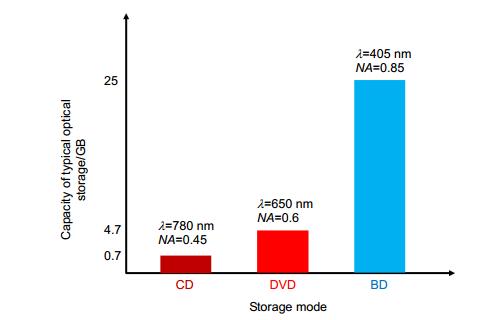
 下载:
下载:
